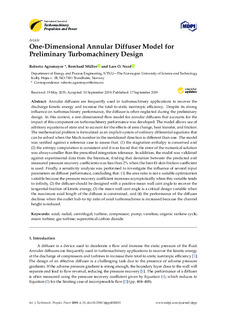| dc.contributor.author | Agromayor, Roberto | |
| dc.contributor.author | Müller, Bernhard | |
| dc.contributor.author | Nord, Lars O. | |
| dc.date.accessioned | 2019-09-18T06:37:31Z | |
| dc.date.available | 2019-09-18T06:37:31Z | |
| dc.date.created | 2019-09-17T11:32:26Z | |
| dc.date.issued | 2019 | |
| dc.identifier.citation | International Journal of Turbomachinery, Propulsion and Power. 2019, 4 (3), . | nb_NO |
| dc.identifier.issn | 2504-186X | |
| dc.identifier.uri | http://hdl.handle.net/11250/2617322 | |
| dc.description.abstract | Annular diffusers are frequently used in turbomachinery applications to recover the discharge kinetic energy and increase the total-to-static isentropic efficiency. Despite its strong influence on turbomachinery performance, the diffuser is often neglected during the preliminary design. In this context, a one-dimensional flow model for annular diffusers that accounts for the impact of this component on turbomachinery performance was developed. The model allows use of arbitrary equations of state and to account for the effects of area change, heat transfer, and friction. The mathematical problem is formulated as an implicit system of ordinary differential equations that can be solved when the Mach number in the meridional direction is different than one. The model was verified against a reference case to assess that: (1) the stagnation enthalpy is conserved and (2) the entropy computation is consistent and it was found that the error of the numerical solution was always smaller than the prescribed integration tolerance. In addition, the model was validated against experimental data from the literature, finding that deviation between the predicted and measured pressure recovery coefficients was less than 2% when the best-fit skin friction coefficient is used. Finally, a sensitivity analysis was performed to investigate the influence of several input parameters on diffuser performance, concluding that: (1) the area ratio is not a suitable optimization variable because the pressure recovery coefficient increases asymptotically when this variable tends to infinity, (2) the diffuser should be designed with a positive mean wall cant angle to recover the tangential fraction of kinetic energy, (3) the mean wall cant angle is a critical design variable when the maximum axial length of the diffuser is constrained, and (4) the performance of the diffuser declines when the outlet hub-to-tip ratio of axial turbomachines is increased because the channel height is reduced. | nb_NO |
| dc.description.abstract | One-Dimensional Annular Diffuser Model for Preliminary Turbomachinery Design | nb_NO |
| dc.language.iso | eng | nb_NO |
| dc.publisher | MDPI | nb_NO |
| dc.relation.uri | https://doi.org/10.5281/zenodo.2634095 | |
| dc.rights | Navngivelse 4.0 Internasjonal | * |
| dc.rights.uri | http://creativecommons.org/licenses/by/4.0/deed.no | * |
| dc.title | One-Dimensional Annular Diffuser Model for Preliminary Turbomachinery Design | nb_NO |
| dc.type | Journal article | nb_NO |
| dc.type | Peer reviewed | nb_NO |
| dc.description.version | publishedVersion | nb_NO |
| dc.source.pagenumber | 26 | nb_NO |
| dc.source.volume | 4 | nb_NO |
| dc.source.journal | International Journal of Turbomachinery, Propulsion and Power | nb_NO |
| dc.source.issue | 3 | nb_NO |
| dc.identifier.doi | http://dx.doi.org/10.3390/ijtpp4030031 | |
| dc.identifier.cristin | 1725548 | |
| dc.relation.project | Norges forskningsråd: 257632 | nb_NO |
| dc.relation.project | Norges forskningsråd: 255016 | nb_NO |
| dc.description.localcode | © 2019 by the authors. Licensee MDPI, Basel, Switzerland. This article is an open access article distributed under the terms and conditions of the Creative Commons Attribution (CC BY) license (http://creativecommons.org/licenses/by/4.0/). | nb_NO |
| cristin.unitcode | 194,64,25,0 | |
| cristin.unitname | Institutt for energi- og prosessteknikk | |
| cristin.ispublished | true | |
| cristin.fulltext | original | |
| cristin.qualitycode | 1 | |

